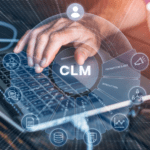
Transforming your approach to risk and compliance with an AI-fuelled contract management solution
By Mark Presbury – Head of Sales at Legal Interact
As a compliance and risk professional, it’s up to you to tightly manage the financial, operational, legal, and reputational risks associated with the contracts your organisation signs. You’re also tasked with the essential role of ensuring that contracts comply with data protection laws, labour laws, industry-specific regulations and other legal requirements.
This is by no means easy in an environment where laws and regulations across different jurisdictions are evolving at high speed. Handling large numbers of different types of contracts can be overwhelming, especially when many corporate compliance teams are understaffed and under-resourced.
One of the keys to strengthening the compliance team and mastering these challenges lies in automation. All too many compliance and risk functions are still taking a manual approach to contract management. They spend massive amounts of time and energy on routine tasks rather than providing insight to the business to support strategic decisions.
A modern contract lifecycle management solution (CLM), enriched with artificial intelligence, can be a game-changer for your compliance and risk team. Today, you can get an affordable, cloud-based solution with rand pricing.
Here’s why such a solution has become an indispensable tool for compliance and risk professionals.
Streamline contract creation: Many compliance teams still spend a lot of their time drafting routine agreements and then checking that they’re compliant with relevant legislation and regulations. A CLM solution will provide you with standardised templates and clauses that speed up contract creation while reducing the risk of non-compliance due to outdated or non-standard language.
Enhanced due diligence: Modern CLM software will include an advanced AI engine to automatically review third party contracts to identify risks. It can also help collect and analyse information about potential contractors to ensure that they meet your compliance standards and don’t expose your business to undue risk.
Automated workflows and approvals: A CLM solution enables you to track contracts from negotiation and creation to eventual renegotiation, renewal or termination. It will automate workflows at each stage. This reduces the chance of human error and ensures that each contract receives the compliance and risk management oversight.
Centralised contract repository: In the absence of lack of a centralised, online storage system, it’s not unusual to lose track of documents scattered in filing cabinets, file directories, and hard drives. CLM provides a single, searchable repository for all contracts. This allows you to easily monitor agreements and related documents as well as to retrieve documentation when you need it.
Proactive compliance monitoring: You can configure your CLM solutions to monitor compliance with internal policies and external regulations. It can send alerts for renewals, expirations, and other critical dates, ensuring that contracts remain current and enforceable.
Reporting and analytics: CLM systems offer robust reporting capabilities that provide you with insights into your contract portfolio. These insights can inform strategic decisions and help you identify areas of potential risk or non-compliance.
Audit trail: A CLM solution records every action taken on a contract, providing a historical record that can be invaluable during audits or legal proceedings.
Data protection and privacy: Contracts often contain sensitive information. Your CLM solution should offer robust security features to protect this data, including access controls, encryption, and secure storage. This will enable you to maintain confidentiality and to comply with data protection regulations.
In today’s complex business environment, AI-powered CLM tools play an essential role in running a high-performing compliance and risk team. By automating routine tasks, they enable your teams to focus on higher-value advisory work rather than repetitive manual tasks.






